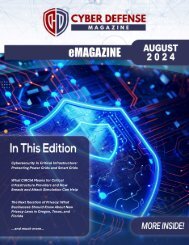Cyber Defense eMagazine February Edition for 2023
Cyber Defense eMagazine February Edition for 2023 #CDM #CYBERDEFENSEMAG @CyberDefenseMag by @Miliefsky a world-renowned cyber security expert and the Publisher of Cyber Defense Magazine as part of the Cyber Defense Media Group as well as Yan Ross, Editor-in-Chief and many more writers, partners and supporters who make this an awesome publication! Thank you all and to our readers! OSINT ROCKS! #CDM #CDMG #OSINT #CYBERSECURITY #INFOSEC #BEST #PRACTICES #TIPS #TECHNIQUES
Cyber Defense eMagazine February Edition for 2023 #CDM #CYBERDEFENSEMAG @CyberDefenseMag by @Miliefsky a world-renowned cyber security expert and the Publisher of Cyber Defense Magazine as part of the Cyber Defense Media Group as well as Yan Ross, Editor-in-Chief and many more writers, partners and supporters who make this an awesome publication! Thank you all and to our readers! OSINT ROCKS! #CDM #CDMG #OSINT #CYBERSECURITY #INFOSEC #BEST #PRACTICES #TIPS #TECHNIQUES
You also want an ePaper? Increase the reach of your titles
YUMPU automatically turns print PDFs into web optimized ePapers that Google loves.
These authentication checkpoints can also drag down productivity if security settings aren’t streamlined<br />
or are prone to error. Employees could find themselves erroneously locked out of systems or applications<br />
important to their work.<br />
A federal agency may have to rethink its security strategy to adopt zero trust, which realistically requires<br />
a holistic approach. This kind of technology restructuring, especially when legacy systems are involved,<br />
means protection gaps may go unnoticed — a serious risk.<br />
Observability is key to zero trust.<br />
Zero trust alone can’t provide all the visibility that security teams need to see across their dispersed<br />
environments.<br />
Agencies must wed zero trust to AI-powered cloud observability tools, which can spot gaps in protection<br />
and ensure a seamless and secure shift to hybrid and multicloud architectures. These AI solutions<br />
automatically monitor data and identify and remediate potentially threatening activity in real time.<br />
Just like with zero trust, the concept of observability grew in popularity as organizations across the globe<br />
embarked on digital trans<strong>for</strong>mation and began building massive cloud-native environments. They found<br />
they needed solutions to help observe their expensive networks and make sense of data in context to<br />
the technology stack as a whole, and they needed it in real time.<br />
Without this kind of observability, they couldn’t fully understand the effects on users and the business.<br />
But traditional observability tools didn’t fully satisfy their needs. There<strong>for</strong>e, IT chiefs at federal agencies<br />
should obtain tools that provide advanced AI-assisted observability and collect data from all system<br />
components.<br />
Traditional observability provides IT teams with aggregated data from three main sources: traces,<br />
metrics, and logs. The most modern tools should offer the same in<strong>for</strong>mation but also deliver data on fullstack,<br />
end-to-end, code-level observability.<br />
IT teams need AI-assisted automation<br />
IT teams need technologies that provide continuous, automatic discovery and instrumentation and<br />
always-on coverage with zero manual configuration. Automation is key here.<br />
Traditional observability approaches typically required developers to manually instrument code, but this<br />
clunky process is inefficient and even unrealistic when thousands of hosts and microservices cross global<br />
and multicloud infrastructures.<br />
And through code-level, precise root-cause analysis, a causation-based AI engine is also vital <strong>for</strong><br />
discerning actionable answers to serious problems.<br />
<strong>Cyber</strong> <strong>Defense</strong> <strong>eMagazine</strong> – <strong>February</strong> <strong>2023</strong> <strong>Edition</strong> 104<br />
Copyright © <strong>2023</strong>, <strong>Cyber</strong> <strong>Defense</strong> Magazine. All rights reserved worldwide.


















